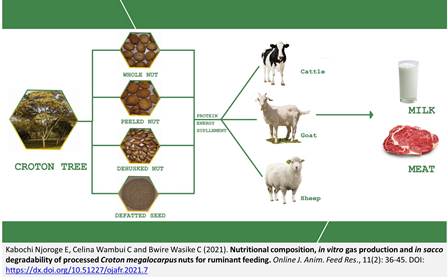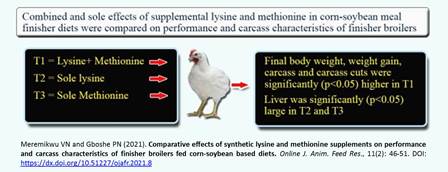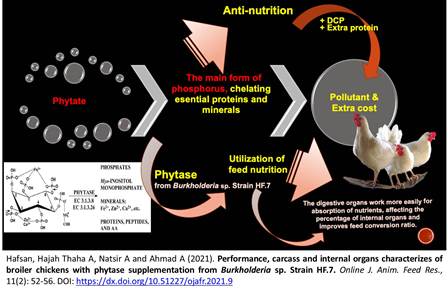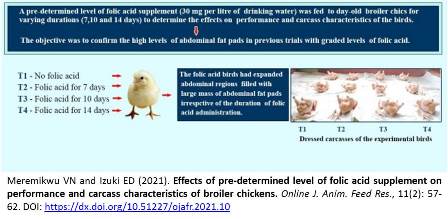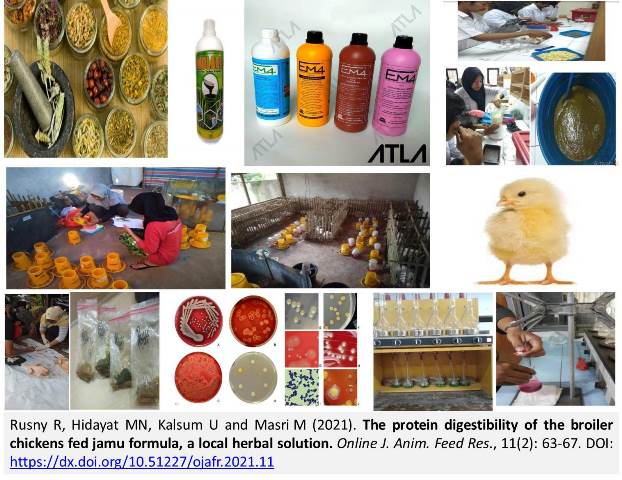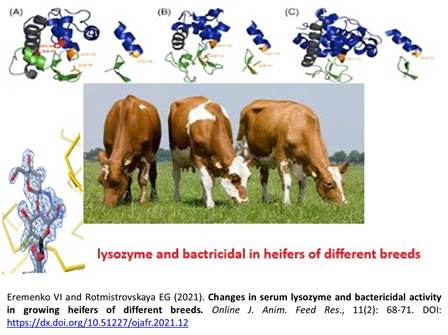Previous issue | Next issue | Archive
![]() Volume 11 (2); March 25, 2021 [Booklet] [EndNote XML for Agris]
Volume 11 (2); March 25, 2021 [Booklet] [EndNote XML for Agris]
Nutritional composition, in vitro gas production and in sacco degradability of processed Croton megalocarpus nuts for ruminant feeding
Kabochi Njoroge E, Celina Wambui C![]() and Bwire Wasike C.
and Bwire Wasike C.
Online J. Anim. Feed Res., 11(2): 36-45, 2021; pii: S222877012100007-11
DOI: https://dx.doi.org/10.51227/ojafr.2021.7
Abstract
This study was conducted to evaluate the effects of processed croton nut on chemical composition, in vitro gas production and in sacco degradability. Four forms of croton nut namely: whole nut (WN), peeled nut (PN), De-husked nut (DhN) and De-fatted seed (DfS) were subjected to proximate analysis, Van Soest fibre fractionation, mineral composition analysis, phytochemical and aflatoxin tests. Degradability analyses were conducted using in vitro gas production and in sacco degradability techniques. Defatted seeds recorded significantly high level of CP and NFE (198 g/kg and 174 g/kg), whereas, ash content and ether extract (EE) were significantly high in WN (59 g/kg) and DhN (362 g/kg) respectively. Low fibre fractions of NDF (556 g/kg) and ADF (490 g/kg) were observed in DhN, while the mineral content was high in DfS which had calcium at 2.13 g/kg and phosphorus at 5.04 g/kg. High level of flavonoid was recorded in WN (124 g/kg), whereas low level of alkaloids was found in DfS (60 g/kg) and tannins in PN (7.1 g/kg). The potential in vitro gas production (a+b) was highest in DfS (22.2 ml/0.2 gDM) while potential in sacco degradability (a+b) was highest in DhN (58.4 %). High level of organic matter digestibility (OMD) (41 %) was observed in DfS. At kp=0.025 rumen outflow rate, DhN had the highest effective degradability of dry matter (56.6%), while the rate effective crude protein degradability was 80.0 %. Processing through peeling and dehusking improved the protein, energy and mineral content of DhN and DfS while crude fibre content reduced. Nutritional composition and degradability characteristics of all forms of croton nuts imply that they could be used in a total mixed ration (TMR) to supply requisite nutrients for maintenance of ruminant animals, while DhN and DfS could be used to supplement energy and protein for increased productivity.
Keywords: Chemical composition, Croton nut, degradability, Gas production technique, Processing.
[Full text-PDF] [Scopus ID: 85103698069] [ePrint] [HTML] [ePub] [XML] [Export citation to RIS & EndNote] [How to Cite]
Comparative effects of synthetic lysine and methionine supplements on performance and carcass characteristics of finisher broilers fed corn-soybean based diets
Online J. Anim. Feed Res., 11(2): 46-51, 2021; pii: S222877012100008-11
DOI: https://dx.doi.org/10.51227/ojafr.2021.8
Abstract
The aim of this research was to investigate the effects of lysine and methionine supplements in corn-soybean meal diets for finisher broilers, by comparing their combined and sole effects on performance and carcass characteristics of the birds. Parameters measured were performance (body weight, weight gain, feed intake, feed conversion ratio and mortality), dressed weight, dressing percentage, carcass cuts and internal organs. The experimental diets were: T1 (control) = lysine + Methionine, T2 (sole lysine) and T3 (sole methionine) supplements. Final body weight, weight gain, carcass and carcass cuts were significantly higher in the control (lysine + methionine) than in the sole supplemented diets, while sole supplementation with methionine (T3) produced significant higher values than sole lysine (T2) in the above mentioned parameters The liver was significantly enlarged in the birds that received the sole supplemented diets. Due to the enlarged liver of the birds fed the sole supplemented diets, it was concluded that supplementation with both lysine and methionine is indispensable in corn- soybean meal based diets for finisher broilers.
Keywords: Amino acid, Broiler, Lysine, Methionine, Supplement.
[Full text-PDF] [Scopus ID: 85103718564] [ePrint] [HTML] [ePub] [XML] [Export citation to RIS & EndNote] [How to Cite]
Performance, carcass and internal organs characterizes of broiler chickens with phytase supplementation from Burkholderia sp. Strain HF.7
Hafsan![]() , Hajah Thaha A, Natsir A and Ahmad A.
, Hajah Thaha A, Natsir A and Ahmad A.
Online J. Anim. Feed Res., 11(2): 52-56, 2021; pii: S222877012100009-11
DOI: https://dx.doi.org/10.51227/ojafr.2021.9
Abstract
Feed formulation with phytase supplementation is an innovation in the feed industry to improve monogastric feed quality without increasing production costs. This study aims to determine the carcass weight of broilers and the percentage of internal organs by providing various feeds, including those supplemented with phytase in phytase units (FTU) from Burkholderia sp. strain HF.7. A completely randomized experimental design was used in this study, using 108 broilers for five weeks of maintenance in three treatments with six replicas, each replica consisting of six broilers. The experimental feed given to broilers was basal feed without phytase supplementation (P1), basal feed + 750 FTU phytase (P2) and commercial feed (P3), each with the category of starter phase and finisher phase. Carcass weight and percentage of organs in broilers (liver, heart, gizzard, and lymph) were measured in each treatment unit. The results showed that broilers that consumed phytase supplemented feed had a higher carcass weight with a lower feed conversion value than broilers fed basal feed without phytase. These findings also indicate that the addition of phytase from Burkholderia sp. HF.7 strain at 750 FTU/kg feeds does not interfere with the organs of broilers' physiological function because of no increase in the percentage of the liver, heart, gizzard, and lymph.
Keywords: Broiler, Burkholderia, Internal organs, Performance, Phytase.
[Full text-PDF] [Scopus ID: 85103712581] [ePrint] [HTML] [ePub] [XML] [Export citation to RIS & EndNote] [How to Cite]
Effects of pre-determined level of folic acid supplement on performance and carcass characteristics of broiler chickens
Online J. Anim. Feed Res., 11(2): 57-62, 2021; pii: S222877012100010-11
DOI: https://dx.doi.org/10.51227/ojafr.2021.10
Abstract
A pre-determined level of folic acid supplement (30 mg per litre of drinking water) was fed for varying durations (7, 10 and 14 days) from day-one of age to determine the effect on performance and carcass characteristics of broilers. The objective was to confirm the high levels of abdominal fat pads in previous trials with graded levels of folic acid, to clarify the mechanism underlying adipose tissue growth in broilers. Parameters measured were body weight, weight gain, feed intake, feed conversion ratio, folic acid intake, mortality and dressed weight, dressing percentage, carcass cuts and internal organs. Data obtained were analyzed using statistical package for social sciences. The outstanding result of this research was on the conformation of the dressed carcasses of the folic acid treated birds, characterized by expanded abdominal regions filled with large mass of abdominal fat pads. There was no difference between the control and the folic acid birds in other parameters measured, except the group on the longest duration of folic acid supplementation, which had higher feed intake. Folic acid intake increased significantly with increase in the duration of administration. It was concluded that, the large mass of abdominal fat pads of the folic acid birds were as a result of cell multiplication (hyperplasia) due to the fact that folate-mediated one-carbon units transfer reactions support rapid proliferation of cells and are important during periods of active cell division.
Keywords: Abdominal fat, Broiler, Folic acid, Pre-determined level, Supplement.
[Full text-PDF] [Scopus ID: 85103737401] [ePrint] [HTML] [ePub] [XML] [Export citation to RIS & EndNote] [How to Cite]
The protein digestibility of the broiler chickens fed jamu formula, a local herbal solution
Rusny R, Hidayat MN, Kalsum U and Masri M![]() .
.
Online J. Anim. Feed Res., 11(2): 63-67, 2021; pii: S222877012100011-11
DOI: https://dx.doi.org/10.51227/ojafr.2021.11
Abstract
Jamu (local herbal drinking) have been known for a long time by inhabitants in Indonesia as conventional home grown pharmaceutical and to progress digestion system within the body. Jamu, not as it were for people but also for creatures. Local farmers have moreover utilized jamu for chicken for a long time, and it’s utilize is expanding. This Research points to decide the impact of jamu to extend protein in vivo digestibility in broilers and for knowing the ideal level of jamu for optimum protein digestibility in broilers. The strategy utilized in this investigate is Completely Randomized Design (CRD) with 4 treatment and 5 replications, each redundancy comprises of 1 broiler chickens, so there are 20 chickens. The treatment comprises of P0 (control), T1 (jamu 1.5 mL/500 mL), T2 (jamu 2.5 mL/500 mL) and T3 (jamu 3.5 mL/500 mL). The parameters watched were digestibility protein in broilers. Based on the examination of fluctuation, it appears The treatment had no critical impact on chicken protein broilers' digestibility given jamu. However, seeing each treatment's average value, T1, T2 and T3 tend to increase to 99.62%, 99.68% and 99.71%, respectively. In conclusion, supplemented with jamu formula does not significantly affect broiler chicken protein's digestibility, but the digestibility increases with increasing formula, up to the formula 3.5 mL/500 mL (T3) as the ideal level.
Keywords: Broiler, Digestibility, Herbal treatment, Jamu, Protein.
[Full text-PDF] [Scopus ID: 85103715156] [ePrint] [HTML] [ePub] [XML] [Export citation to RIS & EndNote] [How to Cite]
Changes in serum lysozyme and bactericidal activity in growing heifers of different breeds
Eremenko VI![]() and Rotmistrovskaya EG.
and Rotmistrovskaya EG.
Online J. Anim. Feed Res., 11(2): 68-71, 2021; pii: S222877012100012-11
DOI: https://dx.doi.org/10.51227/ojafr.2021.12
Abstract
The study presents the results of a study of the bactericidal and lysozyme activity of blood serum of heifers of different breeds. The experiment involved 4 groups of heifers, 10 heads in each group: 1) Black-and-white Holstein; 2) Simmental; 3) Aberdeen-Angus; and 4) crosses of Simmental and Aberdeen-Angus breeds. Animals of all groups were kept in the same feeding and housing conditions. During the experiments, the animals were fed according to generally accepted standards. Blood was taken from animals from the tail vein in the morning before the first feeding in compliance with the aseptic rules. It was found that with an increase in gestation, the activity of serum bactericidal activity (SBA) and serum lysozyme activity (SLA) in the blood of heifers gradually increases.in conclusion, during pregnancy, the level of SBA and SLA in the blood of heifers depended on the month of pregnancy and the breed of animals. During pregnancy, hybrid heifers have higher levels of SBA and SLA, and relatively low levels of SBA and SLA are observed in Black-and-White, Simmental and Aberdeen Angus heifers.
Keywords: Aberdeen-Angus, Bactericidal, Heifer, Lysozyme activity, Simmental.
[Full text-PDF] [Scopus ID: 85103706601] [ePrint] [HTML] [ePub] [XML] [Export citation to RIS & EndNote] [How to Cite]
Previous issue | Next issue | Archive![]()
| < Prev | Next > |
|---|

